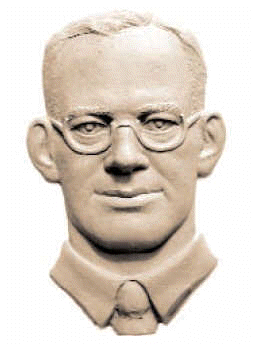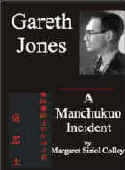Gareth Jones
[bas relief by Oleh Lesiuk]
HOME |
Stop Press |
Complete Soviet Articles & Background Information |
Précis of Gareth's
|
All Published Articles |
BOOKS
|
|
|
|
More Than Grain of Truth(2005) |
|
|
TOPICAL
'Are you Listening NYT?' U.N. Speech - Nov 2009 |
Gareth Recognised at Cambridge - Nov 2009 |
Reporter and the Genocide - Rome, March 2009 |
Order of Freedom Award -Nov 2008 |
Premiere of 'The Living' Documentary Kyiv - Nov 2008 |
Gareth Jones 'Famine' Diaries - Chicago 2008 |
Aberystwyth Memorial Plaque 2006 |
GENERAL
Scholarship Fund |
Site Map |
Links |
Legal Notices |
Sponsored Links |
Contact |
The Manchester Guardian, May 9th 1933.
Agriculture in Russia
Breakdown Denied
To the Editor of the Manchester Guardian,
Sir, - Your correspondent recently in the U.S.S.R. has made a number of assertions about the state of agriculture and the peasantry. Perhaps we may be permitted the following observations:-
-
The Soviet press in general and the reports of the Collective Farmers’ Congress and Central Committee Plenum in particular, have been full for six months past of local material showing mismanagement and breakdowns in agriculture, as well as the successes attending upon businesslike management. The main reports at the congress, in particular, were made up of such material. Comparison with “the proceedings of a provincial debating society” is worse than a travesty. It is a pity that your correspondent in his investigations overlooked Stalin’s speech on January 11 declaring that, for agricultural difficulties, “responsibility falls completely and wholly on the Communists.”
-
The average amount of corn left in the country during the last four years (of the first Five-Year Plan), after deducting exports, has been 73,000,000 tons, as against 38,000,000 in 1910-14. Out of this 50,000,000 to 60,000,000 tons has been held by the mass of the peasantry (i.e., deducting State grain collections), whereas before the revolution most of the corn left in the country was held by the 2,000,000 kulaks and landowners. To talk about “granaries of Europe,” therefore, is beside the point. In Tsarist days the mass of the peasantry went hungry, ragged, illiterate, and lousy. To-day they are better fed, than ever before, wear better clothes (boots, for example), and have nearly wiped out illiteracy; not to speak of village baths, libraries, crèches, &c.
-
Of course there are places where slackness and negligence have led to low output of grain, waste, and pilfering, with disastrous results. The congress itself declared: “There are still not a few collective farms with more weeds than grain on their fields.” To talk of “no grain anywhere”, however, and particularly of seed supplies being inadequate, is nonsense. On March 26 - when your correspondent’s articles were appearing - 93 percent of the national plan of seed collections had been completed, with 92 percent in North Caucasus, 90 percent in the Ukraine, 101 percent in Western Siberia, &c. Seeds are not produced by passing resolutions.
-
Since collectivisation began five years ago, the cultivated area has increased from 250,000,000 to 320,000,000, of which the collective farms’ section has risen from 150,000,000 to 220,000,000 acres. There has been a big expansion in the area sown and the harvest of industrial crops. It has been demonstrated that the working days required to till one hectare of land have been more than halved by the transition to collective methods. We could quote – and so could your correspondent, by reference to the congress proceedings (not Stalin’s speech, but the reports of scores of local delegates), - actual figures, in pounds of grain and kopeks per head per working day, to show how in hundreds of collective farms the wellbeing of the individual has gone up. Leather boots, warm brick cowhouses, brick granaries, crèches, electric plant, reading-rooms, &c. acquired or constructed by successful collective farms have proved their superiority. To argue from numerous and admitted failures (in a system of 230,000 large enterprises exactly three years old) that collectivisation “in a qualitative sense” is a failure – in the light of these facts - is somewhat rash. That term is too mild to apply to your correspondent’s confident prophesies about the spring sowings. Actually 33,250,000 acres had been sown by April 20, as against 15,500,000 acres by the same time last year. The Ukraine has sown nearly 100 per cent more than last year, the North Caucasus 12 ½ per cent , the Lower and Middle Volga enormously more.
-
Your correspondent gives the scantiest of evidence about a military occupation of the agricultural areas. Why does he not mention the name of the “small country town” which was swarming with soldiers? The parties of kulaks under arrest which he saw prove nothing; and surely he did not expect them to keep their moveable property when they were being expropriated! More significant is his admission that the armed militia he saw was itself composed of peasants. There is a class war going on in the villages but it is of the poor and middle peasantry against the kulaks. The role of leader has fallen upon the “political sections” of the Soviet farms and tractor depots. The Soviet papers have published the biographies of the Communists sent to lead these sections in hundreds of cases, and those who are military or G.P.U. men are a small minority. Why does your correspondent not quote chapter and verse, instead of talking generalities about the peasants being driven into the fields “by military terrorism” (a sheer impossibility in any country, but particularly in the U.S.S.R.)?
-
The most detailed and ample evidence of kulak activities, backed in the North Caucasus and the Ukraine by White ex-officers, was given by local delegates at the Central Executive Committee of Soviets in January, and again at the Collective Farmers’ Congress. We would refer your readers if they are interested, to the April issue of our journal “Russia To-day” for many examples. One woman delegate, Tkacheva, from the North Caucasus, recounted how the Poltava staniza “said they had no grain, and didn’t carry but the grain collection plans. We deported this village. I helped to deport them. After they went grain was dug out of the graves. You find pits under the beds, under the stoves. The same at Slavinsk. There in the neighbouring collective farm they have got nothing, but you find grain in the pits”. Why did the kulaks succeed in persuading whole villages, in some cases, to conceal their grain? Your correspondent thinks it was because people feared they would have nothing to eat. Numerous facts revealed at the congress show a different explanation – that, in the of the free trade in farm produce announced, the kulaks wanted to “hold up” the State (inter alia, for high prices). Not an uncommon practice even in the British Empire.
-
The “compulsory labour decree” for the northern timber region, referred to by your correspondent in the last of his articles, was in reality a party circular, and not a decree. It imposed compulsion on none except on Communists and Soviet officials – to engage in a campaign on the subject. So far from your correspondent’s story of every male adult in the month of March being “forced to cut and transport timber” corresponding to reality, the actual fact is that on March 26 a leading article in “Pravda” was denouncing the party organisation in this very region because only 1200 workmen had been got together for timber transportation work by March 18, whereas 123,000 were required. There is not a breath or syllable in the article in the whole article about compulsion; but there is a good deal about insufficiently attractive conditions failing to induce workmen to sign on. We regret that your correspondent has presented such a misleading picture of the Soviet Union. It is being already discovered by the march of events within a few weeks of publication – Yours, &c.,
E. H. Brown, for the National Committee of the Friends of the Soviet Union.
33, Ormond Yard, Great Ormond St, London, WC1.
May 3.
[We desire the other side the cases to be stated, but we have no reason to doubt the essential accuracy of the articles criticised. We may add that conditions described in the articles are not to be disposed of by even the most liberal use of the term “kulak”. Ed. “GUARD”.]
|
|
|
|



